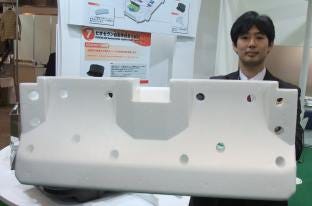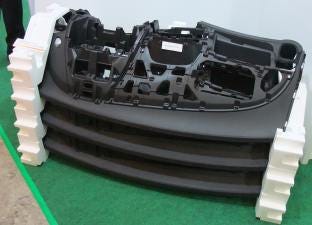Foams made from polystyrene, polypropylene, polycarbonate, and even biodegradable polylactic acid (PLA) will play a key role in vehicle lightweighting moving forward according to foam bead supplier and molder JSP Corp. (Tokyo, Japan). The company sees potential for another 10 kg of foam use in addition to the 5-6 kg that is estimates is currently used.
November 7, 2011
Foams made from polystyrene, polypropylene, polycarbonate, and even biodegradable polylactic acid (PLA) will play a key role in vehicle lightweighting moving forward according to foam bead supplier and molder JSP Corp. (Tokyo, Japan). The company sees potential for another 10 kg of foam use in addition to the 5-6 kg that is estimates is currently used.
On show at the IPF show in Japan was a concept foam sandwich door, with partially bio-derived unsaturated polyester (UP) resin covering both sides of an expanded PLA foam. While the UP resin is currently glass fiber, theoretically natural fiber could also be used as a reinforcing material according to Hidehiro Sasaki, General Manager of the Development Department at JSP. The door weighs in at 9 kg, including around 1 kg of PLA foam.
|
Prototype door module comprises unsaturated polyester sandwiching polylactic acid (PLA) foam. |
|
Polycarbonate foam (orange tag) may join expanded polypropylene (blue tags) in auto applications. |
|
Rear seat bases represent a substantial potential market for foamed plastics |
|
Expanded polystyrene finds use as a protective packaging material for automotive components. |
Fellow IPF exhibitor Sekisui Chemical (Osaka, Japan) pegs foam usage at 10 kg per vehicle for the OEMs that it serves. The company's strategic product is a blend of PS foam and polyethylene foam, Piocelan, that exhibits superior compression strength as compared to EPP foam and can be molded on conventional EPS machines. Almost all vehicles in Japan employ foamed plastic in floor pads that offer protection to the driver and passengers according to Mitsuhiko Anan, Manager of Technology Development at Sekisui. This translates to 1 kg of material at an expansion ratio of 15x.
A new application in vehicles is a rear seat core that is overmolded in a polyurethane processing machine. This represents an additional 1 kg at an expansion ratio of 30. Seat applications represent a promising area for foam plastics according to Anan. Other growth areas include trunk tool boxes, tire spacers, and trunk spacers. A potential major application in the future is hybrid vehicle battery protection.
EPS is also used by at least one Japanese automaker (Nissan) for protective packaging for shipping parts. A motorcycle manufacturer (Honda) also employs EPS packaging for certain types of component kits it ships to overseas assembly plants. EPS is facing competition, however, from thermoformed PET sheet for part shipment, which is a solution also provided by Sekisui.-[email protected]
You May Also Like






